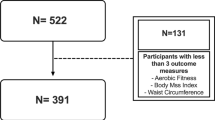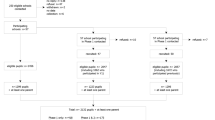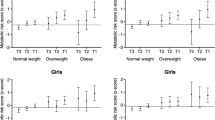Abstract
There is concern that interventions that use physical activity to prevent obesity in children might be undermined by an ‘Activitystat’, which exerts an effect to maintain a low set point for physical activity. The present critique summarises evidence from systematic reviews of interventions, from empirical tests of the Activitystat hypothesis, from studies on the heritability of physical activity in childhood and the physical activity of children of and adolescents across a wide range of physical and cultural environments. This body of evidence is inconsistent with the Activitystat hypothesis in its current form, and suggests that the emphasis on physical activity in obesity prevention interventions in children should be increased, not reduced.
This is a preview of subscription content, access via your institution
Access options
Subscribe to this journal
Receive 12 print issues and online access
$259.00 per year
only $21.58 per issue
Buy this article
- Purchase on Springer Link
- Instant access to full article PDF
Prices may be subject to local taxes which are calculated during checkout
Similar content being viewed by others
References
Jimenez-Pavon D, Kelly J, Reilly JJ . Associations between objectively measured habitual physical activity and adiposity in children and adolescents: systematic review. Int J Pediatr Obes 2010; 5: 3–18.
Wilkin TJ, Mallam KM, Metcalf BS, Jeffery AN, Voss LD . Variation in physical activity lies with the child, not his environment: evidence for an ‘Activitystat’ in young children. Int J Obes 2006; 30: 1050–1055.
van Sluijs EM, McMinn AM, Griffin SJ . Effectiveness of interventions to promote physical activity in children: systematic review of controlled trials. Br Med J 2007; 335: 703.
Dobbins M, De Corby K, Robeson P, Husson H, Tirilis D . School-based activity programs for promoting physical activity and fitness in children and adolescents age 6–18 years. Cochrane Database of Syst Rev issue 1, 2009.
Reilly JJ, Penpraze V, Hislop J, Davies G, Grant S, Paton JY . Objective measurement of physical activity and sedentary behaviour: review with new data. Arch Dis Child 2008; 93: 614–619.
National Institute of Health and Clinical Excellence. Promoting physical activity for children and young people. NICE PH17, January 2009. www.nice.org/PH1 (accessed 29 October 2010).
National institute of health and clinical excellence physical activity and the environment. NICE PH8, January 2008. www.nice.org/PH1, (accessed 29 October 2010).
Summerbell CD, Waters E, Edmunds L, Kelly SAM, Brown T, Campbell KJ . Interventions for preventing obesity in children. Cochrane Database of Syst Rev, issue Date: 3 June 2005.
Rowlands AV . Methodological approaches for investigating the biological basis of physical activity in children. Pediatr Exerc Sci 2009; 21: 273–278.
Eisenmann JC, Wickel E . The biological basis of physical activity in children: revisited. Pediatr Exerc Sci 2009; 21: 273–279.
Rowland TW . The biological basis of physical activity. Med Sci Sports Exerc 1998; 30: 392–399.
Prentice A, Jebb S . Energy intake/physical activity interventions in the homeostasis of weight regulation. Nutr Rev 2004; 61: s98–104.
Butte NF, Ellis KJ . Comment on ‘Obesity and the environment: where do we go from here? Science 2003; 301: 598.
Metcalf BS, Hosking J, Jeffery AN, Voss LD, Henley W, Wilkin TJ . Fatness leads to inactivity, but inactivity does not lead to fatness. Arch Dis Child 2011, doi:10.1136/adc.2009.175927.
Faulkner GEJ, Buliung RN, Flora PK, Fusco C . Active school transport, physical activity levels, and body weight of children and youth: a systematic review. Prev Med 2009; 48: 3–8.
Van Sluijs EMF, Fearne VA, Mattocks C, Riddoch C, Griffin SJ, Ness A . The contribution of active travel to children's physical activity levels: cross-sectional results from the ALSPAC study. Prev Med 2009; 48: 519–524.
Pate RR, Ward DS, O’Neill JR, Dowda M . Enrollment in physical education is associated with overall physical activity in adolescent girls. Res Q Exerc Sport 2007; 78: 265–270.
Baggett CJ, Stevens J, Catellier DJ, Evenson KR, McMurray RG, He K et al. Compensation or displacement of physical activity in middle school girls. Int J Obes 2010; 34: 1193–1199.
Dale D, Corbin CB, Dale KS . Restricting opportunities to be physically active during school time: do children compensate by increasing physical activity ? Res Q Exerc Sport 2000; 71: 240–248.
Fisher A, Van Jaarsveld CHM, Llewellyn C, Wardle J . Environmental influences on children's physical activity: quantitative estimates using a twin design. PLOS ONE 2010; 5: e10110.
Franks PW, Ravussin E, Hanson RL, Harper IJ, Allison DB . Habitual physical activity in children: the role of genes and the environment. Am J Clin Nutr 2005; 82: 901–908.
Plomin R, Foch TT . A twin study of assessed personality in childhood. J Pers Soc Psychol 1980; 39: 680–688.
Ojiambo R, Easton C, Casajus JA, Konstabel K, Thairu K, Anjila E et al. Impact of urbanisation on objectively measured physical activity levels, sedentary behaviour, and indices of adiposity in highly active individuals. J Phys Act & Health, In press.
Prista A, Nhantambo L, Saranga S . Physical activity assessed by accelerometry in rural children and adolescents. Pediatr Exerc Sci 2009; 21: 4–17.
Esliger DW, Tremblay MS, Copeland JL, Barnes JD, Huntington GE, Bassett DR . Physical activity profile of old order Amish, Mennonite, and contemporary children. Med Sci Sports Exerc 2010; 42: 296–303.
Tremblay MS, Barnes JD, Copeland JL, Esliger DW . Conquering childhood obesity: is the answer in the past ? Med Sci Sports Exerc 2005; 37: 1187–1194.
Bassett DR, Tremblay MS, Esliger DW, Copeland JL, Barnes JV, Huntington GE . Physical activity and BMI of children in an old order Amish community. Med Sci Sports Exerc 2007; 39: 410–414.
Strong WB, Markam RM, Blimkie CJ, Daniels SR, Dishman RK, Gutin B et al. Evidence based physical activity for school age youth. J Pediatr 2005; 146: 732–737.
Malina RB, Little LB . Physical activity: the present in the context of the past. Am J Hum Biol 2008; 20: 373–391.
Acknowledgements
This study was funded by Scottish Funding Council.
Author information
Authors and Affiliations
Corresponding author
Ethics declarations
Competing interests
The author declares no conflict of interest.
Rights and permissions
About this article
Cite this article
Reilly, J. Can we modulate physical activity in children?. Int J Obes 35, 1266–1269 (2011). https://doi.org/10.1038/ijo.2011.62
Received:
Revised:
Accepted:
Published:
Issue Date:
DOI: https://doi.org/10.1038/ijo.2011.62
Keywords
This article is cited by
-
Within- and between-day associations between children’s sitting and physical activity time
BMC Public Health (2015)
-
Physical activity and motor skills in children attending 43 preschools: a cross-sectional study
BMC Pediatrics (2014)
-
Children, parents and pets exercising together (CPET): exploratory randomised controlled trial
BMC Public Health (2013)
-
The ActivityStat Hypothesis
Sports Medicine (2013)
-
Children, parents, and pets exercising together (CPET) randomised controlled trial: study rationale, design, and methods
BMC Public Health (2012)



